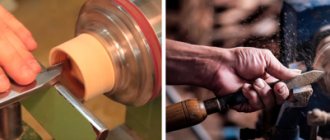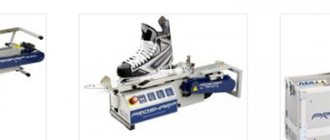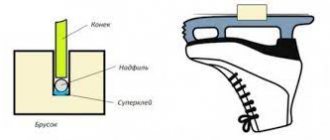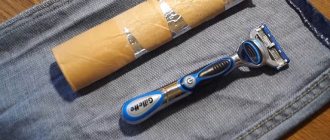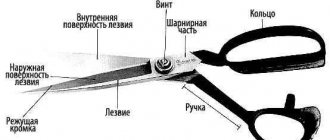You can't skate for long in hockey on stupid skates. If you want to play hockey, you will have to take care not only of your physical fitness, but also of the condition of your equipment. To perform maneuvers and glide easily and steadily, sharpened skate blades are required. There is no need to talk about the importance of this procedure. Professionals and amateurs of the game must understand that the result of a meeting with an opponent depends on every little detail.
From time to time you have to ask yourself this question, but here problems with understanding and choice arise. Where to go? How to sharpen? How to choose the right sharpening? Can you sharpen it at home like kitchen knives?
You should only go to sharpening specialists if you decide to take hockey seriously. But this article will help you understand the varieties.
Profiling hockey skate blades
Professionally made sharpening allows the skates to have maximum gliding and contact with the ice.
Blade preparation occurs in two stages:
- Profiling. They change the geometry of the blade to suit the individual characteristics of the hockey player.
- Hockey skate sharpening (gutter sharpening).
Basic concepts:
- Blade profile (profile radius) - the contour of the blade from toe to heel.
- The central top point on the blade. She takes on all the load when riding.
- An area or spot that touches the ice.
The platform is the main working part of the skate. Responsible for stability and speed. The greater the weight and height of the hockey player, the larger the size of the spot in contact with the ice.
The profile radius affects the player’s maneuverability, but if you increase it, you can worsen the stability of the skate on the ice. An athlete of great weight and height should have a larger profile radius. This will help the skate to better contact the surface.
Each player on the ice has his own task. Therefore, the profile of a defender is not suitable for a striker. For a hockey player, it is important to find a balance between agility and stability on the ice.
The factory parameters of the circuit, as a rule, are insufficient for normal movement of a hockey player during the game.
The standard pad size does not exceed 10 mm, and the rib sharpening radius is 13-15 feet.
There are three methods to increase the contact patch with ice:
- profile “Site”;
- single (classic, radius);
- combined (double, triple).
Useful articles on choosing and caring for hockey equipment:
- How to properly wrap a hockey stick
- How to choose a hockey bag
- Choosing hockey skates for a child
- How to choose the right hockey helmet
- Choosing a hockey puck
- How to properly put a hockey uniform on a child
https://youtu.be/https://www.youtube.com/watch?v=FzsUwdd-EpE
_
Subtleties of skate care
We have already said that any sports equipment requires special care. This also applies to skates. Skates last longer from quality care. And riding them will only be a pleasure.
Let's look at the main points of skate care:
- First, watch for rust. This is the main enemy of any metal. To extend the life of your skates, keep the blades free of snow and ice. This procedure must be followed after each trip to the skating rink. Next, wipe all parts dry. Place the hard case on top and stash it in your gym bag. It is also recommended to use soft covers for each blade.
- Secondly, pay attention to where you store your skates. Store skates in a dry place, away from temperature changes. Otherwise, the risk of rust becomes higher.
- Third, your skates must be broken in correctly. Otherwise, the material of the skates will become covered with cracks, stretch marks and become severely deformed.
- Fourth, dry your skates properly. They should be dried naturally, unlaced. Do not use the battery as a way to quickly dry your skates!
- Fifthly, monitor the condition of the blades. It is important to correctly determine when it is necessary to sharpen the blades. Ideally, the blade should be very sharp, without nicks or burrs.
If you have little experience or are a beginner, it is still better to take your skates to a special service and show them to a specialist. After all, safety on ice comes first! The importance of timely sharpening of skates should never be underestimated. Below you can see how to do the work yourself at home without a machine with step-by-step instructions in the video.
https://youtu.be/https://www.youtube.com/watch?v=j4VTSuYRnJo
_
Classic profile
The radius longitudinal profile is measured by the radius in feet. For example: 14″ designation means the radius of the profile template is 14 feet. Used for profiling the blades of hockey skates: children's, beginner hockey players and amateurs. Sharpening is done on machines according to factory patterns with a sharpening radius from 7″ to 30″.
The most popular single profile patterns for children's skates:
- 11″ - for small players with good skating skills;
- 15″ - for young beginners;
- 17″ - for beginner young players with a lot of weight.
How to choose hockey equipment for a child, read our articles
Skates Stick Helmet Hockey bag Puck
Figure skates (blades) from HD Sports, brand - Mitchell & King (MK).
| Blades | Geometry and dimensions | ||
| Radius of curvature, feet | OH,inches | Dimensions | |
| Gold Star | 7′ | 7/16″ | 7-12″ |
| Phantom | 7′ | 7/16″ | 7-12.5″ |
| Phantom Special | 7′ | 7/16″ | 8.25-11.75″ |
| Vison | 7′ | 7/16″ | 7.25-12.25″ |
| Professional | 7′ | 7/16″ | 7-12.5″ |
| Vison Syncro | 7′ | 7/16″ | 7-12″ |
| Dance | 7′ | 5/16″ | 8-12.5″ |
| Double Star | 7′ | 1″ | 7-12.5″ |
Combined profiling method
The blade of a hockey skate can be divided into three working zones: toe, middle, heel. Each zone is responsible for performing its own maneuver (turn, turn, slide).
The essence of the method. Each part of the blade has its own spot of contact with the ice. After profiling, a blade with a complex configuration is obtained. Sharpening is carried out only on specialized machines using templates. This method is popular among professional players.
Detroit Templates
A dual sharpening style for ice hockey skates like the Detroit 1 (10-20ft) provides the player with the most stability on the ice. At the same time, speed and maneuverability are slightly reduced.
For goalies, players who skate a lot with their backs forward, and heavy defensive players, the Detroit 2 (13-26 feet) is suitable.
Zuperior Templates
The triple type of sharpening is used to increase balance, speed, and maneuverability.
There are several Zuperior templates:
- S (6-12-26 ft) - skate blade size 24.6 cm; 25.4 cm; 26.3 cm;
- M (6-13-26 ft) - 27.2 cm; 28 cm; 28.8 cm;
- L (6-14-26 ft) -29.6 cm; 30.6 cm; 31.2 cm.
- V (6-17-26 feet) -29.6 cm; 30.6 cm; 31.2 cm - used for goalkeepers and heavy players.
All templates give athletes additional stability during the game, which does not affect speed.
FIGURE SKATES (BLADES) BY HD SPORTS, BRAND - JOHN WILSON (JW).
| Blades | Geometry and dimensions | ||
| Radius of curvature, feet | OH,inches | Dimensions | |
| Gold Seal | 8′ | 5/16″ | 8-12″ |
| Pattern 99 | 8′ | 7/16″ | 7-12.5″ |
| Super Dance 99 | 8′ | 5/16″ | 8-12″ |
| Four Aces | 7′ | 7/16″ | 7-12.25″ |
| Сoronation Dance | 7′ | 7/16″ | 5.75-12.5″ |
| Coronation Comet | 8.5′ | 7/16″ | 7-12.5″ |
| Coronation Ace | 7′ | 7/16″ | 5.75-12.5″ |
| Wilson Precision | 8′ | 7/16″ | 7-12″ |
| Majestic | 7′ | 5/8″ | 5.75-12.75″ |
| Jubilee | 7′ | 3/4″ | 7-12″ |
Types of sharpening hockey skates
The convenience of play and the safety of the athlete depends on the correct sharpening of hockey skates. There are several standards that apply during the procedure.
The basic term is groove (gutter). You can often see names such as radius, notch, groove.
The sharpening radius (groove depth) is affected by:
- athlete's weight;
- hockey player's skating style;
- hockey player skill level.
The numbers in the table indicate the depth of the groove. In this case, the lower the value, the deeper the recess will be and the sharper the edges. More value means less depth of the groove, less sharpness of the edge.
Table of standard groove values for sharpening hockey skates of a forward
| Athlete's weight, kg | ||||||
| Athlete's level of training | 20-30 kg | 30-50 kg | 50-70 kg | 70-90 kg | 90-110 kg | 110 and above kg |
| Professional | 12-14 m1 | 13-16 mm | 14-17 mm | 15-20 mm | 17-25 mm | 20-30 mm |
| Amateur | 10-13 mm | 12-14 mm | 13-15 mm | 17-30 mm | 15-18 mm | 16-20 mm |
| Beginning | 9-12 mm | 10-12 mm | 11-12 mm | 12-13 mm | 13-15 mm | 14-16 mm |
Table of standard groove values for sharpening defender's hockey skates
| Athlete's weight, kg | ||||||
| Athlete's level of training | 20-30 kg | 30-50 kg | 50-70 kg | 70-90 kg | 90-110 kg | 110 and above kg |
| Professional | 11-13 mm | 12-14 mm | 13-15 mm | 14-17 mm | 15-20 mm | 18-25 mm |
| Amateur | 10-12 mm | 11-13 mm | 12-14 mm | 15-20 mm | 14-16 mm | 15-18 mm |
| Beginning | 9-12 mm | 10-12 mm | 11-12 mm | 12-13 mm | 13-15 mm | 14-16 mm |
You need to focus not only on the table, but also on the player’s personal preferences.
- For stable skating and with turns, you should choose a sharpening with a deep groove - from 9 to 14 mm.
- To increase the rolling speed, you will need to increase the groove size to 20 mm or more.
Main types of sharpening:
- Radius (standard sharpening).
- Channel-Z
- Flat Bottom V.
How can you sharpen your skates yourself?
Many people think that there is no need to sharpen new skates since they are already from the factory. This is not true, factory sharpening is suitable only for a few. Therefore, you will have to try. The most interesting thing is that athletes trust only a few with this work. These are sharpening professionals. After all, a small error can cause a fall when performing complex tricks.
Ways to sharpen skates:
- File
- Nadfilkom
- Bulgarian
How can you sharpen your skates yourself?
Sharpening Channel-Z
A special feature of this type of sharpening is the presence of an additional notch in the middle of the standard groove. It is made in the form of a square.
Channel-Z has its own sequence of sizes. The depth can be 0.8-1.6 mm. The channel width is divided into 3 types - S, M, L.
Among the advantages noted:
- Increased maneuverability and riding speed.
- Reducing resistance.
- An additional recess collects ice crumbs that melt during the game. Melted water is an additional lubricant that ensures better gliding of the skate.
Among the minuses noted:
- High cost of the service.
- The process takes longer.
- Sharpening requires professional equipment (Sweden).
- Sharpening can only be done by a highly qualified specialist.
Graf Blades
| Blades | Geometry and dimensions | ||
| Radius of curvature, feet | OH, inches | Dimensions | |
| Lausanne | 8′ | 7/16″ | 8-12″ |
| Junior Comp | 8′ | 7/16″ | 8-12″ |
| Silver Star | 7′ | 5/8″ | 8-12″ |
| Cyber Star | 7′ | 5/8″ | 8-12″ |
| Platinum | 8′ | 7/16″ | 8-12″ |
| Diamond | 7′ | 5/8″ | 8-12″ |
| Dance blades | |||
| Dance | 7′ | 5/8″ | 8-12″ |
Sharpening "FBV"
For more than 25 years, a Canadian development, FBV, has been used to sharpen skates. In this case, the groove takes the shape of a trapezoid, which allows you to achieve a good efficiency when skating.
Flat Bottom “V” has a number of advantages:
- Rigid adhesion of the blade to the ice.
- Increased stability.
Among the disadvantages, athletes note the fragility of sharpening. Since the thin trapezoidal walls cannot withstand the load, roughness and chips appear.
How to tell if your skates are dull
Sharpening of hockey skates is required immediately after purchase and during use. There are several signs that ammunition has become dull:
- When starting to move, the skate slips.
- There is a feeling of stalling when turning.
- When you run the tip of your nail along the blade, there is no mark left on the nail plate.
Look at the outline from the front. Both edges must be of equal height and a groove must be visible. When turning at right angles, the blade profile has the shape of the letter P. If other parameters are observed during inspection, sharpening is necessary.
How to care
For long-term service, equipment must be properly cared for daily. Buy a case designed specifically for storage and carrying. Do not leave the blade wet or damp for a long time. There is a high probability of damage to the product or rusting. After each use, wipe the equipment with a dry cloth. You can treat it with machine oil, then wrap it in paper.
Keep away from sunlight and heating devices. Off the ice, special protective covers are placed on the base of the tip. If you follow the recommendations mentioned above, the skates will last a long time. Daily care will eliminate additional sharpening and the need to purchase new ice equipment.
It is worth noting that skate equipment is not cheap. It is important to care for them after each use: wipe the blade with a damp cloth and put on protective covers. In order not to spoil the product, you should not try to sharpen it yourself; it is still better to entrust this task to professionals.
Sharpening hockey skates at home
Blade sharpness is important for hockey skates. Because the speed and maneuverability of the player depends on the correct sharpening. When sharpening ammunition at home, you need to follow a number of rules that will help you avoid common mistakes.
Main mistakes and their consequences
| Error | Consequences of an error |
| The inner and outer sides of the blades are not symmetrical. | Leads to loss of balance. |
| A lot of steel has been removed from the toe and heel. | The skate is unbalanced and the balance is lost. |
| Blade overheating. | The durability of the metal decreases. |
| Blade profile and groove radius are damaged | Negatively affects the quality of skating. |
How to sharpen hockey skates
To properly sharpen skates, you can use the following equipment:
- Needle files or files are necessary for direct sharpening.
- An abrasive whetstone or a plastic slingshot - removes burrs after the first stage of processing.
You can sharpen the blade with a regular whetstone or on a sharpening machine. When using any of the listed items, it is important to follow the sharpening technology. The slightest deviation from the standards will lead to damage to sports equipment. It is best to trust a professional hockey skate sharpener.
Finishing
To achieve the required sharpness and desired angle, it is important to fine-tune after sharpening by choosing one of three possible methods:
- removing burrs with a diamond abrasive stone;
- polishing with a polishing stone;
- finishing with a rough finishing stone, performing work at a certain angle.
The last two options are recommended when sharpening sports skates. When using the latter method, at the final stage you should treat the blade with a special oil that reduces friction.
Professional sharpening experts recommend removing less metal and focusing on more frequent sharpening.
The use of professional machines increases the efficiency of the work performed and promotes long-term use of the blades. Share link: Return to list of articles
Useful tips
The frequency of sharpening skates depends on how actively the player skates. With regular training 4-5 times a week, sharpening should be done every 3 days. Professional athletes easily feel the need to sharpen their skating quality. Young hockey players should focus on the following nuances:
- Socks move apart on the ice.
- Burrs and roughness are visible on the edge.
- If you run a blade across the skin, it will leave scratches.
- Visually inspect the site.
On the bottom of the blade the layer of metal is 1-2 mm. When sharpening, the machine removes no more than 0.1 mm. After 20 sharpenings, the equipment becomes unsuitable for riding.
Another question that worries beginners is whether it is worth sharpening new ammunition. Ready-to-skate skates are only available from Reebok (T-blade model).
Jackson Ultima Skates Blades
| Blades | Geometry and dimensions | ||
| Radius of curvature, feet | OH, inches | Dimensions | |
| Mirage Blade - UB10 | 8′ | 1/2″ | 7 1/4-11″ |
| Protege Blade - UB40 | 8′ | 7/16″ | 7 1/4-11″ |
| Legacy Blade - UB50 | 8′ | 7/16″ | 7 1/4-11″ |
| Freestyle Blade - UB120 | 8′ | 7/16″ | 8 1/4-12″ |
| Elite Blade - UB105 | 8′ | 7/16″ | 8 1/4-12″ |
| SUPREME Blade - UB150 | 8′ | 7/16″ | 8 1/4-12″ |
| Dance blades | |||
| Ultima Dance Blade - UB115 | 8′ | 7/16″ | 8 1/4-12″ |
Instructions for operating skate sharpening machines
- Sharpmaster Profil is a machine for sharpening and profiling skates.
- Sharpmaster Golden Mean is a skate sharpening machine.
- SSM-2 - a machine for sharpening skates.
- Sparx ES100 + PS100 - a machine for sharpening skates.
- Prosharp is a machine for sharpening and profiling skates.
You will find more useful articles about hockey in the sections:
- Add Listing
- Dashboard
- IQ in football. How smart football players play
- Login or Register
- SPORTUNIVER - online sports university
- Alexander Kolikov
- Alexandra Puriga
- Alena Aronovich
- Alena Novikova
- Anastasia Nikitina
- Andrey Aronovich
- Andrey Mazurov
- Andrey Osadchenko
- Athlete profile: tell us about your child's achievements
- Anton Politov
- Basketball of Champions: Basics
- Run! Jump! Throw! IAAF Official Athletics Training Guide
- Running in the stream. How to enjoy sports and improve your results
- The Hockey Coach's Bible
- Biochemistry of motor activity. Textbook
- Valentina Barkova
- Introduction to training theory. IAAF Official Athletics Training Guide
- Vera Zolotykh
- Volleyball. Initial training
- Volleyball: theory and practice. Textbook for higher educational institutions of physical culture and sports
- Restoring the performance of football players
- All articles
- All-Russian network of children's sports schools in rhythmic gymnastics and sports acrobatics "FD"
- Gayane Baghdasaryan
- Motor qualities and physical training of athletes
- Diet of Champions
- Diary of an Athlete. Toolkit
- Evgeniy Gulenkov
- Elena Krischenko
- Elena Serko
- Elena Shmatova
- Elizaveta Lileeva
- Uploading a file
- Posts
- Irina Levina
- How to talk so children will listen, and how to listen so children will talk
- How bad do you want it? Psychology of mind over body
- How to become an expert in the “Child in Sports” project
- Kirill Kuzmin
- NBA Coaches Book. Techniques, tactics and coaching strategies from basketball geniuses
- Talent code. Geniuses are not born. They become
- Kristina Kutepova
- Athletics: Basics (Q&A)
- Manifesto of a great coach: how to turn a good athlete into a great champion
- Margarita Belyaeva
- Maria Sharapova, Unstoppable. My life
- Mark Midler. The Tale of a Fencer
- Medical and biological technologies in physical culture and sports
- Methodology for training young football players
- Microelements and sports. Personalized correction of the elemental status of athletes
- Microelements and sports. Personalized correction of the elemental status of athletes
- Heart rate monitoring in the management of the training process in physical culture and sports
- Mental training in the psychological preparation of an athlete
- Find a sports organization
- Natalya (project creator)
- Natalia Bukharina
- Don't yell at children! How to resolve conflicts with children and get them to listen to you
- Unbroken
- National Medical Research Center for Pediatric Traumatology and Orthopedics named after. G.I. Turner
- Novak Djokovic – the hero of tennis and the face of Serbia
- New school in football training
- Educational
- Teaching the basic elements of figure skating
- Learn table tennis in 5 steps
- Communicate with the child. How?
- Organization of methodological work in a sports school
- Crucial moment. Winning strategy in practice
- Athlete nutrition
- Athlete nutrition
- Nutrition for athletes. Recommendations for practical application (using the example of football)
- Beach volleyball. Management
- Victory at any cost. Psychological weapons in tennis: lessons from the master
- Training athletes of the 21st century. Scientific basis and structure of training
- Training of football players in leading European clubs
- Support the site
- Search by organization
- Personal data privacy policy
- Full immersion. How to swim better, faster and easier
- The procedure for organizing the provision of medical care to those involved in physical culture and sports
- IIHF program “Learning to play hockey.” A practical guide for trainers. Stage B
- Program for early physical development of children (from birth to 10 years)
- Professional selection in sports
- Psychological training for runners
- Goalkeeper Psychology
- Personality psychology of a sports coach
- Psychology of selection in sports games
- Athlete psychology: components of success
- Psychology of a champion. An athlete's work on himself
- Psychology of champions. The mindset that leads to victory in sports and life
- Psychology. Main industries
- Ways of self-improvement of a teacher-trainer using the example of gymnastics
- The path to tennis Olympus
- Development of endurance in athletes
- Development of coordination abilities in preschoolers
- Development of physical abilities in young figure skaters
- Revolution on the lawn. A book about football tactics
- Daily routine of a young hockey player
- Volleyball theater director
- Roger Federer. Legendary world racket
- Guidelines for medical and biological support of training in children's and youth hockey
- Team 2018: champions of our hearts. Cherchesov, Dzyuba, Akinfeev, Cheryshev and other heroes of the 2018 World Cup
- Svetlana Popova
- Svetlana Cherednichenko
- Thank you
- Sport
- Sport is psychology
- Sports medicine. Course of lectures and practical exercises
- Sports medicine. Handbook for doctors and trainers
- Sports medicine: textbook
- Sports talent: forecast and implementation
- Athlete, musician, poet, mathematician... How to identify and develop your child's abilities
- Sprint running
- Handball player training equipment
- Secret support. Attachment in a child's life
- Tatyana Zharkova
- Tatiana Obolentseva
- Tennis. Psychology of successful gaming
- Theory and methodology of handball
- Theory and methodology of training young football players
- Theory and methodology of synchronized swimming
- Theory and methodology of modern sports research
- Theory and methodology of rhythmic gymnastics. Artistry and ways of its formation
- Theory and methodology of rhythmic gymnastics. Sports reserve training
- Theory and practice of sports fencing
- Terminology of sports fencing in training and competitions
- Testing and monitoring the preparedness of football players
- Managing the training of athletes in table tennis
- Successful trainer. The most authoritative guide to coaching
- Risk factors and measures to prevent injuries to the musculoskeletal system in young athletes
- Factors of sports selection, or Who becomes an Olympic champion
- Fencing. Encyclopedia. AND I
- Physiology of strength
- Physiology of sports. Tutorial
- Human physiology. General. Sports. Age. 6th edition
- Physical preparation of qualified judokas for the main competition of the year
- Physical development and physical training of young volleyball players
- Functional readiness of volleyball players. Diagnosis, adaptation mechanisms, symptom correction
- Football. A book about skill and drive
- Football. Book-trainer
- Football. Handbook for children's trainer. Stage I (8-10 years)
- Football. Handbook for children's trainer. Stage II (11-12 years old)
- Football. Handbook for children's trainer. Stage III (13-15 years old)
- Football. Program for football academies, children's and youth sports schools
- Football. Professional lessons for beginners
- Football school Goleador
- Hockey. Founders and newcomers
- Hockey. Strategies and tactics of the best hockey teams
- Gymnastics. History, status and development prospects
- Chess school "Newton's Apple"
- Electrocardiogram of an athlete
- Encyclopedia of testing
- Ergogenic effects of sports nutrition. Scientific and methodological recommendations for coaches and sports doctors
- Relay race. History, technique, training, training
- Yulia Khasanova



